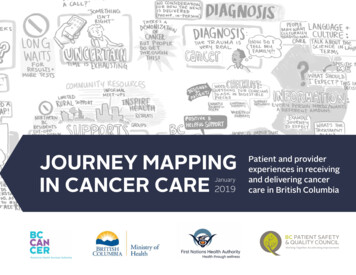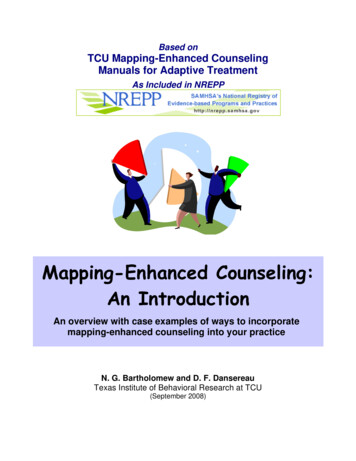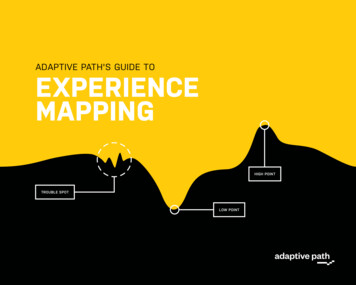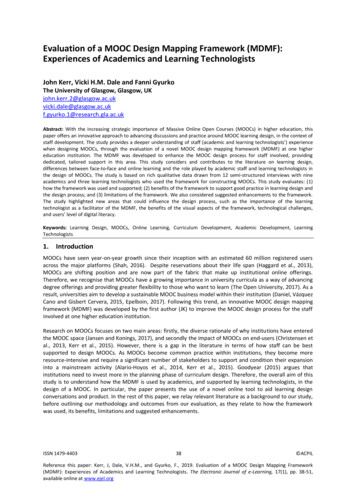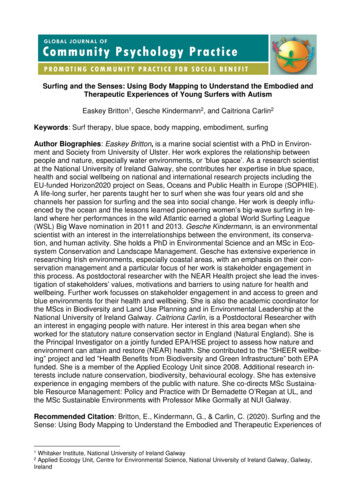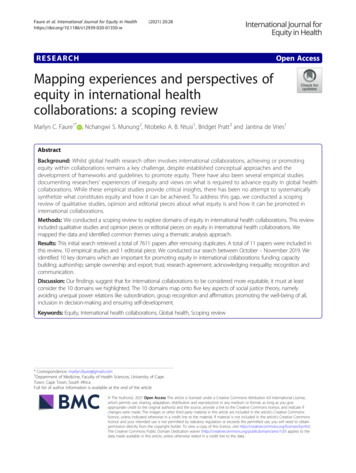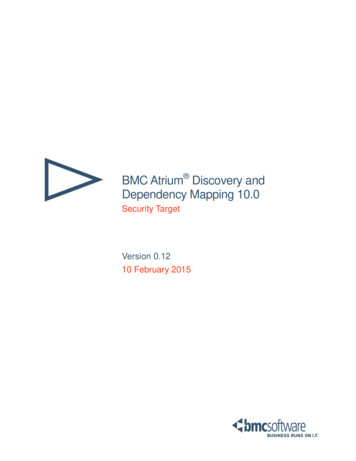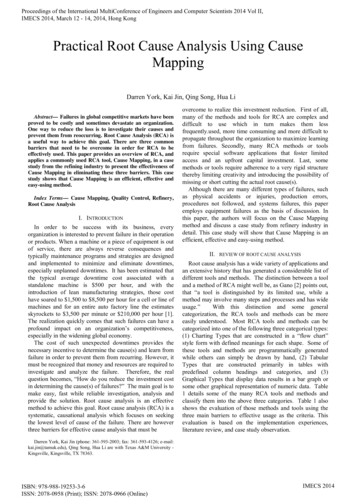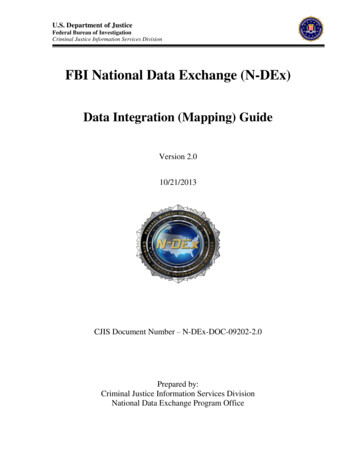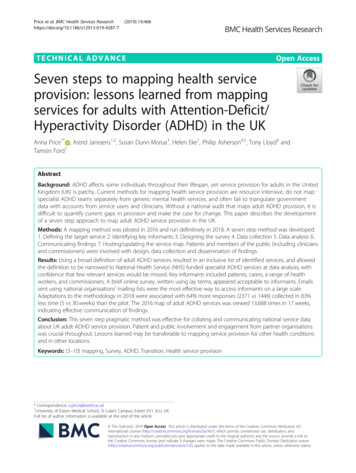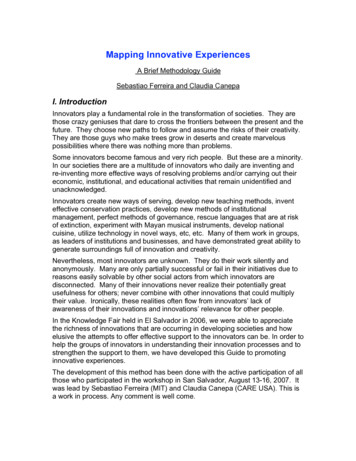
Transcription
Mapping Innovative ExperiencesA Brief Methodology GuideSebastiao Ferreira and Claudia CanepaI. IntroductionInnovators play a fundamental role in the transformation of societies. They arethose crazy geniuses that dare to cross the frontiers between the present and thefuture. They choose new paths to follow and assume the risks of their creativity.They are those guys who make trees grow in deserts and create marvelouspossibilities where there was nothing more than problems.Some innovators become famous and very rich people. But these are a minority.In our societies there are a multitude of innovators who daily are inventing andre-inventing more effective ways of resolving problems and/or carrying out theireconomic, institutional, and educational activities that remain unidentified andunacknowledged.Innovators create new ways of serving, develop new teaching methods, inventeffective conservation practices, develop new methods of institutionalmanagement, perfect methods of governance, rescue languages that are at riskof extinction, experiment with Mayan musical instruments, develop nationalcuisine, utilize technology in novel ways, etc, etc. Many of them work in groups,as leaders of institutions and businesses, and have demonstrated great ability togenerate surroundings full of innovation and creativity.Nevertheless, most innovators are unknown. They do their work silently andanonymously. Many are only partially successful or fail in their initiatives due toreasons easily solvable by other social actors from which innovators aredisconnected. Many of their innovations never realize their potentially greatusefulness for others; never combine with other innovations that could multiplytheir value. Ironically, these realities often flow from innovators’ lack ofawareness of their innovations and innovations’ relevance for other people.In the Knowledge Fair held in El Salvador in 2006, we were able to appreciatethe richness of innovations that are occurring in developing societies and howelusive the attempts to offer effective support to the innovators can be. In order tohelp the groups of innovators in understanding their innovation processes and tostrengthen the support to them, we have developed this Guide to promotinginnovative experiences.The development of this method has been done with the active participation of allthose who participated in the workshop in San Salvador, August 13-16, 2007. Itwas lead by Sebastiao Ferreira (MIT) and Claudia Canepa (CARE USA). This isa work in process. Any comment is well come.
The Intention of the MethodThe general intention of the method is to conduct a process of analyticalreconstruction of innovative experiences that will help their understanding, asmuch on the part of the participants as for the social innovation promoters. Themethod has some specific intentions:a) To understand the process of the innovative experience, its phasesand it points of breakdown and why they occurred.b) To identify the main innovations that has been done, to characterizethe innovative process and its dynamics.c) To understand the present situation of the experience and its strategicperspectives.d) To identify the support required so that the experience can develop toits full potential.Those intentions are achieved by means of a reconstruction of the experience inwhich the participants are invited to rethink their ideas, review the evidence andreconsider their interpretation.For the participants and for the facilitator the application of the method makes itpossible to acquire a new, more profound and more coherent understanding ofthe innovative experience, and to identify where help may be more effective indeveloping the experience.Finally, the application of the method by a variety of persons will contribute to thedevelopment of an analytic tool for innovative experiences and to theimprovement of the cognitive resources of the promoters of social innovation.The Principles of the Method1. Any process with an innovator group ought to be adapted to their cognitiveidiosyncrasies. The specific steps of the method, the language and theterminology used in conversations, the facilitator’s style and thesurroundings ought to be friendly to the innovator group. The facilitatorought to be careful to verify whether his language is contributing to whatthe participants are expressing or is generating barriers to theirexpressions.2. The use of knowledge ought to be agreed in advance by the participants.If the facilitator contributes well to the generation of knowledge, it shouldbe clear that the innovator group has the right to decide what it is going tobe done with the knowledge generated. The experience that will berecovered and analyzed was lived by the innovators and the knowledgederived from that process belongs to them. It may be that the knowledgegenerated is different from what was expected at the beginning of the2
process; therefore it is a good idea to clarify again at the end how theresults of the process will be used; what elements can be disseminatedopenly and what other elements should be held back. The facilitator hasan obligation to respect these agreements.3. When the group has difficulty in articulating an idea, the facilitator ought todevelop tools and cognitive resources (cards, questions, matrices,conceptual maps, diagrams, tables, time lines, etc) at real time for helpingthe group advance gradually.4. The knowledge generated should be expressed in a way that theinnovators can use it after. That means that the level of abstraction, theformat, the language, and terminology in which the knowledge will beexpressed ought to be consistent with the way in which the innovatorgroup expresses and recognizes its ideas. The form ought to be adaptedto the users and not to the facilitator. The results ought to be expressed ina way that the members of the innovator group will feel comfortablereusing them in the future.5. The energy flow of the participants ought to define the way in which theprocess is advanced. The intelligence and the intellectual effort have to besustained by the enthusiasm of the participants. It is true that time is worthmore than money. But it is also true that people’s energy is worth morethan time. The facilitator ought to be especially attentive to the energy flowof the group, to their emotions (happy, worried and sad), blockages,difficulties with respect to certain topics, etc. This could call for a lot ofempathy, sensitiveness and intelligence. The atmosphere should alwaysbe one of satisfaction; even when delicate topics are being addressed.Don’t forget that the ability to do deep analysis depends on the level ofenthusiasm that the group feels about the topics that are being discussed.Each discovery made by the group should be highlighted so that the groupadvancement in the process is clearly perceived.6. The story depends on who tells it. The composition of the group thatparticipates in the reconstruction of the experience should berepresentative of its most important moments and of the multiple actorswho lived the experience. The innovation carried out may have been theresult of a combination of capabilities and perspectives. Having diversesources and perspectives for telling the story can be of great value indiscovering the innovation and to understand the innovative process.It can be a good idea if, in previous conversations, a preliminary review ofthe experience is done in order to identify who ought to be in the exerciseto identify innovations, to describe the innovative process and to explorepossibilities of future.3
Conditions of ApplicabilityThe innovative groups are diverse and their experiences are even more diverse.This means that whatever method is to be applied with them should be a flexibleone.It may be that the innovative group is made up of persons with intellectual andanalytical traditions, who feel comfortable with a more abstract and technicalterminology. It may be that the innovative group is made up of very pragmaticpersons and they won’t feel comfortable with sophisticated language. It can alsobe the case that the group will have very unique social and/or culturalcharacteristics and that those characteristics are little known by the facilitator.It is known that the innovators are very good at innovating but that, generally,they are not so good at understanding or explaining their innovations. Thefacilitator should assume that the innovations done by the majority of theinnovative groups are not clear to them and that the first expressions may bevery confused and even deceiving.The application of the method ought to be understood as an exploratory processof de-construction (reverse engineering) and of reinterpretation of theexperience, a re-learning activity of what we already know, as much for theparticipants as for the facilitator.For the facilitator, especially, the application of the method is going to meanleaving many of his ideas aside and following the thread of the others’ ideas;leaving aside his way of understanding things to help others to develop their ownideas. That doesn’t mean that the facilitator renounces his knowledge and ideas,it means that the facilitator puts his knowledge and ideas at the service of others’thinking, channeling them in the form of questions and of cognitive tools so thathis counterparts manage to construct their own knowledge and to betterunderstand their experiences.The facilitator ought to take the process of the workshops as an emergingphenomenon, that is to say, as a process of discovery where all those involvedwork at the frontiers of their knowledge, incorporating the discoveries aselements that influence the next steps and the way in which they are carried out.Some Assumptions behind the MethodThe current method of analysis of innovative experiences is based on somespecific assumptions.1) We assume that the majority of innovators don’t have a clear awarenessof their innovations or of the innovative processes that they carry out. Themethod proposes to help them to better understand what they do.4
2) The method seeks to understand innovative experiences that were carriedout by persons or groups of people in the context of their economic,institutional and social activities. It doesn’t refer to the innovativeprocesses that occur in universities or in corporation’s laboratories, undercontrolled conditions.3) The method seeks to understand the innovations that occur in the effort ofachieving an objective, as a necessary change in realigning an experiencewith its objectives.The hoped forexperience, originally, toreach the objective, butDesiredObjectiveThe innovation, once achieved,reorients/bends/transforms theexperience towards the objective.Given theproblem, aninnovative effortis triggeredAn emergingproblem turns theexperience far fromthe objectiveWith the innovationincorporated, the experienceadvances toward the objectivePotentialFailure4) It is based on the assumption that the majority of innovations are inresponse to challenges, are efforts to solve problems that have resistedour usual responses, are creative reactions to the inefficiency of the waywe are used to do things.5) We know that exist people who innovate simply because they like to,because they have a creative genius that compels them toward theunknown, toward experimentation, like children and some adolescents.But we believe that the great majority of innovations done by adults arestimulated by a problem or need.5
The MethodThe method has four great moments: the experience, theinnovation, the situation and the future.Identification of the experienceThe identification of an innovative experience is a prerequisite forthe application of the method. All experiences contain elements ofinnovation. The initial evaluation consists of estimating whether theinnovations that the experience bears are valuable enough to meritthe effort needed for an in-depth analysis.The social and economic environment in which innovative experiences aredeveloped can be favorable or unfavorable. If the environment is unfavorable,even though an innovation is very valuable, it can show low levels of successor be successful only on a very small scale. Therefore the level of successand the scale of experiences cannot be the only criteria for identifying aninnovative experience.Naturally, if an innovative experience has generated notable success and hasreached a significant scale, it reinforces the decision to help the innovatorgroup to analyze it. Nevertheless, the level of success should not be anexclusive criterion.The initial effort should be to explore the relevance of the innovativeexperience for other social groups in similar situations. The idea is to observethe innovative experience; mentally exploring how many persons couldbenefit from the contributions of the experience and based on that potentialbenefit, to establish the relevance of the experience and of the innovationsthat it accommodates.For the purposes of this Guide we are going to assume that the experiencehas been identified and that the facilitator thinks that it is worth beingsupported. In those cases it is better to overestimate the potential than toleave out important experiences.1. The experienceThe first thing to be understood is the evolution of the experience,to capture its character, to be aware of its objective, with respect towhat is the group’s experience. That is achieved by helping thegroup to reconstruct its history in the form of a dialog.1.1. Telling the history of the experienceIn this initial phase of the process it is important that the group begins totalk, and keep talking, for being able to remember what has beenhappening. The best recommendation is to organize it as a dialog in whichthe participants begin to tell their stories. The intention is to get an initialidea of what the experience was, a first approximation.6
The facilitator’s questions are noted,at first to maintain the continuity ofthe dialog, to help the groupremember, to understand those thatare vague points and to visualize thevarious elements, so that the peopletell their stories even though othersmembers of the group are notcompletely in agreement with theirversions. The intention in thatmoment is not to decide whatversion of the story is most suitablebut to enrich the understanding withperceptions from a diversity ofperspectives.At the sametime that theparticipantsare telling thestories,someone isdocumentingalmostliterally.In this initial conversation it ispossible that differences will bediscovered, nevertheless, that is notthe purpose compare versions, butto maintain the continuity of theprocess of reconstruction of the experience. Additionally it is important todiscover the diverse circumstances and facets of the experience.The construction of an initial timeline in which the principal events of theexperience are organized temporarily may be very useful. The CriticalMoments reflection Methodology,developed in CoLab@MIT, can beuseful, but there are many options ofdialog and semi-structured methodsof interview.1.2. Achievements (LOGROS, in Spanish)Remembering achievementsproduces satisfaction and theachievements can be the first cluesof possible innovations. In generalthe achievements are results of theinnovations, but it can also be thatthe innovator groups combinelessons learned and innovationsamong their main accomplishments.1The list of achievements of theinnovative experience is a kind ofmap of what the participantsconsider most important. Those points can well serve as a starting point tobegin the analysis of the experience.7
In the case of ESEN, we have a list of achievements that illustrate how theparticipants remember and value their experience. An initial review allowsus to see that there are clear relations among the various achievements.Change ofteacherparadigmsUse oftechnologyImprovedlearningSocial recognitionfrom Ministry ofEducationGreater interest,motivated studentsStudents usingtechnology andalso innovatingMore teachersengaged ininnovationsAccordingly to the participants: The use of technology has resulted inimproved learning, it generated greater interest by the students in studymaterials and a greater level of motivation, which also resulted inimproved learning. These elements have generated social recognitionand a desire among new teachers to use technology. The way in whichthe process advanced made the students start to innovate by themselvesusing technology in order to improve their learning process and didacticmaterials. In order to start the whole process of using technology andinnovation it was necessary to disrupt the pedagogic and technologicalparadigms of the teachers.A logical map of the achievements helps in beginning to understand theexperience; and the particular way that the participants relate them cangive clues in identifying the innovations. That map should be seen as anexploratory tool, a resource for generating questions that help in betterunderstanding the experience. It should not be conclusive since theexploration of the experience is just beginning.1.3. Characterization of the phases and differencesKnowing the experience in its general characteristics and theachievements most emphasized by the participants, the process ofanalysis begins, identifying the phases in their evolution and giving them aname and date (year, month and, in some cases, day)The central premise of that step is that the phases of the experiencesbegin with the execution of some innovation and end in the moments priorto the next innovation.8
The idea that underlies that premise, already pointed out earlier, is that thegreat majority of innovations are responses to emerging problems, thatinnovations areresponses to stimuli andProcess of the Experiencethat stimuli, in general,are problems that thoseinvolved in theexperience had toconfront. 2Phase “A”Phase “B”Phase “C”Once the innovation isincorporated in theTimelineexperience there will beThe innovation is the factor that “breaks” the curvea qualitative leap, aupward (red curved arrow), opening a new phase and aturning point and a newnew period of development of the experience.phase begins. Thatphase will last until anew transformational innovation is generated. That innovation will producea new turning point that will carry the experience to another new phase.3With the exception of thefirst phase that beginswith actions that beganthe initiative, thefollowing phase willbegin with theincorporation of aninnovation; will have adevelopment period,after a time someproblem or opportunitywill emerge, that stimuluswill generate a response(an innovative effort) andthe phase will culminatein the moments ofincorporation of theinnovation thattransforms theexperience, initiating anew phase in theprocess.4After the participants identify each turning point, the Facilitatorsummarizes each turning point to verify if (1) he understandswhat the participant have tried to explain, and/or (2) to help inbetter describing the turning point.Some questions that help in exploring the phases and turningpoints of the experience: How did the experience process go? Did it have clearly identifiable phases? What were they? Can you identify and describe the turning points? What were the factors that produced the turning point, the“Tipping Point”? Besides the turning point, what happened in theexperience? What changes were there in the experience? What new opportunities presented themselves and whatpossibilities appeared? What are the times/moments during which each of theturning points occurred?The facilitator then has to verify if the turning points identified arelinked to innovations, or to external factor (like an injection ofexternal resources)The name of the phasecan refer to an activity that created a different characteristic of the phase,to some central participant, some objective or intention that has directedthe actions, some incident that marked the experience in that phase, etc.9
In summary, it can be any meaningful element that differentiates onephase from the others.To discover the phases, their namesand their dates, matrices can beused, mental maps, rivers of life, orany other cognitive tool that helpsparticipants to visualize the process.2. The InnovationNow that we have an idea of theexperience and have arranged it interms of phases and turning points,we begin the effort of identifying theinnovations.We will call innovation a “new way ofdoing things or a new tool thattransforms experience in order to getmore and better results with thesame resources or to get equalresults with fewer resources”.5Guidance for identifying innovation The most important actions that havebeen done to resolve turning pointsserve as clues to detect innovations The facilitator should avoid identifyingthe innovations – but ask questions tohelp the participants to identify theinnovations by themselves. Afterwards the facilitator ought to askquestions that help the participants tocharacterize the innovation. If it is difficult to do this, the facilitatorcan ask the participants to do adramatization or simulation of theexperience about how the turningpoint was resolved.The steps referring to innovations are done for each phase of theexperience. The level of detail of the analysis of each one of theinnovations can be very different, and frequently, after analyzing oneinnovation, it becomes easier to identify others.2.1. Identification of the innovation, the name and descriptionInnovation is identified by exploring the causes of the changes in theexperiences, the factors that brought the experience to a new phase ofdevelopment. It isn’t necessary to assume that innovations are necessarilytechnical elements. The great majority of innovations carried out by socialgroups don’t refer to new (physical) technologies, but to new ways ofdoing things or new uses or new combinations of existing technologies.What is innovative is not so much in the objects but in the new ways ofusing them. It can be new concepts of social technologies.Once the innovation is identified, it must be given a name. The nameought to refer to the process, object or element that is in the center of thechange that occurred in the experience as a result of it. The name oughtto help analyze the innovation later and to differentiate it from otherinnovations that were carried out during the experience.2.2. Brief description of the innovationThe name is a kind of description, but very brief. The characteristicelements of the innovation ought to be identified and a description donebased on them. The description of the innovation helps in understandingits nature and will serve well in the steps following.10
Is it a method? Is it a new kind of work or a new process or software? Is ita new tool? Is it a new way of using the tools? Is it a new product orservice? Is it a new physical or social technology? Is it a new concept or anew way of using or combining technologies that already exist?2.3. Identification of actors (preliminary version)Once the innovation is described the actors that participated in its creationand implementation must be listed. This list will be preliminary and itspurpose is to help take the next step of building the process of theinnovation. Nevertheless, the facilitator should aim that no one importantactor for the innovation process is forgotten.2.4. Construction of theThe facilitator asks who the actors were. After theinnovation process. This isparticipants respond with an initial list of actors,a crucial step, as importantthe facilitator asks again in order to help them toas the identification of theremember other actors who they may haveinnovation. This stepforgotten on the list.consists of reconstructingWho was involved in the activities during thethe innovation process, thatturning point?is to say, how the groupmanaged to develop the“Have they already explained what persons wereinnovation, through whatinvolved? If they have referred explicitly to 2activities, with what specificactors: A and B. Are they the only ones thatcharacteristics, in whatplayed an important role or were there others?order, to have a clear ideaof how the group wascapable of generating that factor of transformation. The understanding ofthe innovation processes will be key in being able to improve them and inbeing able to replicate them in the future.The innovation processes ought to be analyzed from two perspectives,social and cognitive. The social perspective refers to the way that persons interactamong themselves to advance in the innovation process, to howthe advances and failures of some serve as stimuli so that othersadvance in their innovative ideas, how the exchange of ideasamong peers stimulate the creation of new ideas. The cognitive perspective refers to how the idea of the innovationkeeps developing itself in the framework of old ideas, how somenew ideas generate analogies that modify the old concepts andgenerate space for the development of the innovative idea.o With what methods have they been working?o What types of information or knowledge have they incorporated?11
o How have they been constructing or approaching the innovation?o How have I transformed my understanding of the object that I aminnovating?o Was the innovation done by a group or by individuals?o What group of actors innovated?o Was there a mechanism for the exchange of ideas?Examples of dynamics of innovation are: the “skateboard players” in theDynamics of InnovationThere are dynamics that stimulate creativity in persons:a. Jazz musicians sit together and begin to play. The first begins with music that everyone knows. The onewho is playing inspires him while he is playing, and begins to develop his own inspiration. Theinspiration of that person is contagious to the others and they begin to become more creative, and whenthis person stops playing the other takes his place and develops his own variations. Immediately a thirdmember enters with his contribution and the creativity of the group begins to manifest itself.b. Another dynamic of creativity that is used in workshops is brainstorming. In brainstorming, a personthrows out an idea on a topic. The others listen to the idea while they are forming their own ideas in theirheads. Upon hearing another person’s idea, the listeners end up rounding out their ideas and sharingthem with the group. And the emerging ideas inspire and stir up ideas in the others. That way a flow ofcreativity is generated, that one person cannot achieve alone. It is this stirring up of ideas by otherpeople that disrupts the ideas of each one and allows everyone to shape his ideas in a new way.c. Albert Einstein, in the years before developing his three works that revolutionized physics, created, withtwo other friends, a discussion group of scientists and philosophers that they decided to call OlympicAcademy. The Olympic Academy was three fellows who liked to talk about books and about the ideasthey had about physics, philosophy and math. While talking they were constructing their ideas aboutothers’ ideas. One knew more about philosophy, another knew more of mathematics, and Einstein wasthe physicist. After talking about his personal experience, Einstein says that being part of this Olympicacademy was very important for him; and that in other conversations he managed to organize his ideasbetter and he found new clues of where to explore and structure his ideas.If we manage to identify which were the dynamics that allowed the group to develop its innovations it canbe important in maintaining the creative capacity of the group. Those dynamics can be reconstructed andnourished when the group needs to confront another challenge that requires its creativity.California pools, Einstein’s Olympic Academy, the brainstorming of IDEO,etc. Those dynamics always combine moments of interaction andmoments of isolation, and it is important to understand how they arecombined. 6Some times, the most valuable innovation is not the innovation itself butthe process that made it possible. Many times the innovation process hasmore potential for replication than the innovation itself. The innovationprocess can be called the meta-innovation.2.4.1. Activities for understanding the innovative process. Understandingthe innovation process begins with the description of the activities, asa reconstruction of how it happened. By attempting to remember allthe activities, in what sequence they were done, who did it, and why.12
The intention is to achieve the clearest possible idea of how theinnovation emerged. An effort must be made to be the mostdescriptive possible, avoiding theorizing prematurely. Innovativeprocesses are very specific, and some of the most valuableknowledge is in their surprising and particular aspects. The mentalposture in this exercise ought to be that of a chronicler who describesan event or a biologist who observes nature and describes what hediscovers, it shouldn’t be theoretical but rather pragmatic withtheoretical capacity.2.4.2. Grouping of activities to identify momentsOnce the activities of the innovation process have beenreconstructed, it is necessary to identify how those activities aregrouped in specific moments. The importance of identifying themoments is that it allows better understanding of the innovationprocess.As has been indicated before, the participants in the moments of theprocess may vary. Frequently upon passing from one moment toanother some participants change, some come in and others leave.Frequently the roles also change.The moments of the innovation process can be associated toinnovative dynamics like those described in the musicians’ cases, thebrainstorming and the creative dialogs. There are a variety of authorswho have written about those creative dynamics.72.4.3. Graphic representation of the innovative processVisualization of the innovative process contributes a lot to understandingit. That vi
Mapping Innovative Experiences A Brief Methodology Guide Sebastiao Ferreira and Claudia Canepa I. Introduction Innovators play a fundamental role in the transformation of societies. They are those crazy geniuses that dare t
